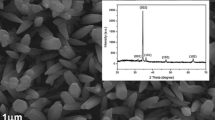Abstract
Template-based sol electrophoretic deposition has been demonstrated as an attractive method for the synthesis of oxide nanorod arrays, including simple and complex oxides in the forms of amorphous, polycrystalline, and single crystal. This paper systematically studied a number of processing parameters to control nanorod growth by sol electrophoretic deposition. The influences of particle and template zeta potentials, condensation rate, deposition rate (or externally applied electric field), the presence of organic additives, and sol concentration on the growth of nanorod arrays were studied. It was found that higher zeta potential or electric field resulted in higher growth rates but less dense packing. Templates with charge opposite to that of the sol particles prevented formation of dense nanorods, sometimes resulting in nanotubes, depending on the field strength during electrophoresis. In addition, the pH of the sol and chelating additives were also varied and likely affected the deposition process by affecting the condensation reactions.
Similar content being viewed by others
References
G.Z. Cao, Nanostructures and Nanomaterials: Synthesis, Properties, and Applications (Imperial College Press, London, 2004).
C.M. Lieber, Solid State Comm. 107, 607 (1998).
Y. Xia, P. Yang, Y. Sun, B. Wu, B. Mayers, B. Gates, Y. Yin, F. Kim, and H. Yan, Adv. Mater. 15, 353 (2003).
G.R. Patzke, F. Krumeich, and R. Nesper, Angew. Chem. Int. Ed. 41, 2447 (2002).
G.Z. Cao, J. Phys. Chem. B108, 19921 (2004).
Y. Lin, G.S. Wu, X.Y. Yuan, T. Xie, and L.D. Zhang, J Phys.-Condens. Mat. 15, 2917 (2003).
S.J. Limmer, S.V. Cruz, and G.Z. Cao, Appl. Phys. A79, 421 (2004).
K. Takahashi, S.J. Limmer, Y. Wang, and G.Z. Cao, Jpn. J. Appl. Phys. 44B, 662 (2005).
S.J. Limmer and G.Z. Cao, Adv. Mater. 15, 427 (2003).
S.J. Limmer, S. Seraji, M.J. Forbess, Y. Wu, T.P. Chou, C. Nguyen, and G.Z. Cao, Adv. Mater. 13, 1269 (2001).
S.J. Limmer, S. Seraji, Y. Wu, T.P. Chou, C. Nguyen, and G.Z. Cao, Adv. Funct. Mater. 12, 59 (2002).
S.J. Limmer, T.P. Chou, and G.Z. Cao, J. Mater. Sci. 39, 895 (2004).
R.J. Hunter, Zeta Potential in Colloid Science (Academic Press, London, 1981).
A. Navarro, J.R. Alcock, and R.W. Whatmore, J. Eur. Ceram. Soc. 24, 1073 (2004).
J. Ma, R. Zhang, C.H. Liang, and L. Weng, Mater. Lett. 57, 4648 (2003).
C. Lettmann, D. Möckel, and E. Staude, J. Membrane Sci. 159, 243 (1999).
K.S. Seshadri, R. Kesavamoorthy, M.P. Srinivasan, K. Varatharajan, J. Ahmed, and V. Krishnasamy, B. Electrochem. 14, 16 (1998).
Y.C. Wang, I.C. Leu, and M.H. Hon, J. Mater. Chem. 12, 2439 (2002).
B.B. Lakshmi, P.K. Dorhout, and C.R. Martin, Chem. Mater. 9, 857 (1997).
K.J. Kim, A.G. Fane, M. Nyström, and A. Pihlajamaki, J. Membrane Sci. 134, 199 (1997).
C. Lettmann, D. Möckel, and E. Staude, J. Membrane Sci. 159, 243 (1999).
M. Kosmulski, Langmuir 13, 6315 (1997).
C.J. Brinker and G.W. Scherer, Sol-Gel Science: The Physical and Chemistry of Sol-Gel Processing (Academic Press, Boston, 1990).
R.K. Iler, The Chemistry of Silica: Solubility, Polymerization, Colloid and Surface Properties, and Biochemistry (John Wiley & Sons, New York, NY, 1979).
C. Sanchez, J. Livage, M. Henry, and F. Babonneau, J. Non-Cryst. Solids 100, 65 (1988).
S. Barboux-Doeuff and C. Sanchez, Mat. Res. Bull. 29, 1 (1994).
R. Nass and H. Schmidt, J. Non-Cryst. Solids 121, 329 (1990).
T. Nishide and F. Mizukami, Thin Solid Films 259, 212 (1995).
N. Tohge, E. Fujii, and T. Minami, J. Mater. Sci.-Mater. El. 5, 356 (1994).
A. Leaustic, F. Babonneau, and J. Livage, Chem. Mater. 1, 248 (1989).
P. Papet, N. Le Bars, J.F. Baumard, A. Lecomte, and A. Dauger, J. Mater. Sci. 24, 3850 (1989).
M. Sedlar and M. Sayer, J. Sol-Gel Sci. Tech. 5, 27 (1995).
S. Basu and K.K. Chatterji, Z. Phys. Chem. (Leipzig) 209, 360 (1958).
K. Yamasaki, K. Sone, Nature 166, 998 (1950).
J. Selbin, Chem. Rev. 65, 153 (1965).
K. Nakamoto, Infrared and Raman Spectra of Inorganic and Coordination Compounds, 3rd (ed.) (John Wiley & Sons, New York, 1978).
Y.-C. Wang, I.-C. Leu, and M.-H. Hon, Electrochem. Solid St. 5, C53 (2002).
Author information
Authors and Affiliations
Corresponding author
Rights and permissions
About this article
Cite this article
Limmer, S.J., Chou, T.P. & Cao, G.Z. A Study on the Influences of Processing Parameters on the Growth of Oxide Nanorod Arrays by Sol Electrophoretic Deposition. J Sol-Gel Sci Technol 36, 183–195 (2005). https://doi.org/10.1007/s10971-005-3548-6
Received:
Accepted:
Issue Date:
DOI: https://doi.org/10.1007/s10971-005-3548-6




